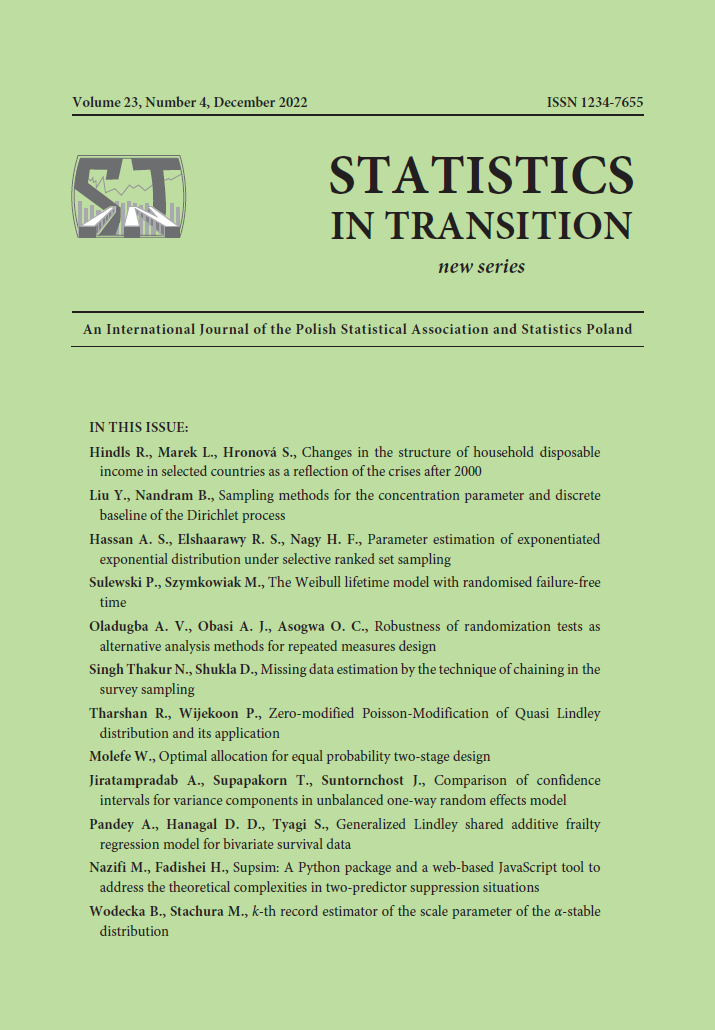ARTICLE
ABSTRACT
This paper develops optimal designs when it is not feasible for every cluster to be represented in a sample as in stratified design, by assuming equal probability two-stage sampling where clusters are small areas. The paper develops allocation methods for two-stage sample surveys where small-area estimates are a priority. We seek efficient allocations where the aim is to minimize the linear combination of the mean squared errors of composite small area estimators and of an estimator of the overall mean. We suggest some alternative allocations with a view to minimizing the same objective. Several alternatives, including the area-only stratified design, are found to perform nearly as well as the optimal allocation but with better practical properties. Designs are evaluated numerically using Switzerland canton data as well as Botswana administrative districts data.
KEYWORDS
sample designs, optimal allocation, composite estimation, mean squared error, two-stage sampling, simple random sampling without replacement
REFERENCES
Bankier, M. D., (1988). Power allocations: determining sample sizes for subnational areas. The American Statistician, 42(3), pp. 174–177.
Clark, R. G., Steel, D. G., (2007). Sampling within households in households surveys. Journal of the Royal Statistical Society A, 170(Issue 1), pp. 63–82.
Cochran, W. G., (1977). Sampling Techniques. Wiley and Sons.
Foreman, E. K., (1991). Survey Sampling Principles. Marcel Dekker, Inc.
Fuller, W. A., (1999). Environmental Surveys Over Time. Journal of Agricultural, Biological and Environmental Statistics, 4, pp. 331–345.
Hansen, M. H., Hurwitz, W. N., and Madow, W. G., (1953). Sample survey methods and theory, volume 1 & 2. Wiley, New York.
Hidiroglou, M. A., Patak, Z., (2004). Domain estimation using linear regression. Survey Methodology, 30, pp. 67–78.
Longford, N. T., (2006). Sample size calculation for small-area estimation. Survey Methodology, 32(1), pp. 87–96.
Molefe, W. B., (2011). Sample design for small area estimation. PhD thesis, University of Wollongong, http://ro.uow.edu.au/theses/3495.
148 W. Molefe: Optimal allocation for equal probability two-stage design Molefe, W. B., Clark, R. G., (2015). Model-assisted optimal allocation for planned domains using composite estimation. Survey Methodology, 41(2), pp. 377387.
Molefe, W. B., Shangodoyin, D. K., and Clark, R. G., (2015). An approximation to the optimal subsample allocation for small areas. Statistics in Transition, new series, 16(2), pp. 163–182.
Pettersson, H., Sisouphanthong, B., (2005). Household Sample Surveys in Developing and Transition Countries, chapter Cost Model for an Income and Expenditure Survey, pages 267–277. Number 96 in Series F. United Nations: Statistics Division, Department of Economic and Social Affairs.
Sukhatme, P. V., Sukhatme, B. V., Sukhatme, S., and Asok, C., (1954). Sampling theory of surveys with applications. Iowa State University Press, third edition.
